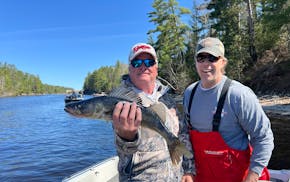Routine work like cleaning campsites, clearing messy portages and trails, and interacting with visitors at ranger stations will take a back seat next camping season across the Superior National Forest in northern Minnesota.
The U.S. Forest Service is facing an expected $500 million budget shortfall that will affect recreation areas including the Boundary Waters Canoe Area Wilderness.
A hiring freeze is in effect ahead of next summer, when the forest managers normally employ temporary workers to help with upkeep. They handle maintenance work like clearing downed trees on portages, digging latrines and removing trash left at forest campsites. Some also work the front desks at the forest's five ranger district offices.
Superior National Forest Supervisor Tom Hall said some of the routine work will fall on 52 permanent seasonal staff members, but it'll be prioritized.
"One of our favorite words now is 'triage,'" Hall said, "Where the most urgent need is, we shift our resources to meet that need. Sometimes you reach that capacity sooner when you have fewer people. We are working through that."
While forest leaders say they are prepared to manage with less, one longtime outfitter suspects campers and visitors will notice come June.
"The Boundary Waters requires a lot of on-trail maintenance work to keep it in good shape," said Jason Zabokrtsky of Ely Outfitting Co. "A decrease in funding that reduces the Forest Service's ability to maintain the wilderness will negatively impact the experience of travelers."
Filling the gaps
The freeze means 23 vacant seasonal jobs will go unfilled next summer. Busy ranger stations like the one in Ely, for example, might merit full staffing during busy season, while others will have limited hours, he said. The LaCroix district site in Cook, Minn., already is down to one permanent seasonal employee in visitor services in the front office. Tofte and Gunflint (Grand Marais) office hours were cut beginning in mid-August because of a lack of workers.
Already in the eastern part of the forest, the Forest Service is understaffed. There are typically 27 people managing recreation inside and outside the Boundary Waters, Hall said. It's now 10, owing to attrition and an inability to fill vacancies because of budget cuts and a lack of applicants.
U.S. Forest Service Chief Randy Moore said in a statement in August that supplemental funding from both the Inflation Reduction Act and the Bipartisan Infrastructure Law is ending, contributing to the budget problems. The agency is expected to get about $500 million less than its request of nearly $9 billion in 2025. The Forest Service operated on a $9.3 billion budget last fiscal year and a little more than $10 billion in 2023.
Plus, federal money allocated in 2020 to tackle a $6 billion backlog of public land maintenance runs out next fiscal year.
Volunteer groups and others who partner with the agency to work across the 3-million-acre national forest will also feel the hit. The Superior National Forest relies on dozens of volunteer organizations to help maintain thousands of miles of trail used by offroad riders, snowmobilers, hikers and others.
"It's been a big focus to catch up on this deferred maintenance. With budget constraints, rather than catch up, we might fall behind," said Jo Swanson, executive director of Northwoods Volunteer Connection, a group in Grand Marais that recently worked on eroded trails. "We hope to be part of the solution. It's going to take one heck of an effort to see the Superior National Forest stays in good shape."
The land conservation challenges run deeper than campsite cleanup and the visibility of rangers, said Chris Knopf, executive director of the advocacy group Friends of the Boundary Waters Wilderness. He said the "hollowing out" of land agencies like the Forest Service and National Park Service goes back decades. Moore told employees in September that the agency has lost 8,000 jobs in the last 20 years.
"People who work at [those agencies] know this is the case," he said. "You can see the importance of public and private partnerships to fill in the gaps."
The Forest Service has been preoccupied by the federal government's possible purchase of more than 80,000 acres of school trust lands — land owned by the state — across the Boundary Waters, Knopf said. The federal agency still is assessing the deal, which would settle negotiations going back more than 10 years.
Knopf said his organization felt compelled to step in to protect more wilderness. In 2022, the Friends organization bought 80 acres of land at the edge of Snowbank Lake in Lake County. Then, last summer, the group bought 2 miles of undeveloped shoreline and 361 acres along the South Kawishiwi River southeast of Ely.
"Where we have chosen to make our mark is on that land conservation," he said.
Hall emphasized that the Superior National Forest has remained nimble amid budget woes and is focused on the safety of staff and visitors. He said the agency continues to fill law enforcement and firefighting vacancies, and is hiring about dozen new wildfire employees. It also received $10 million through the Inflation Reduction Act for projects to mitigate the wildfire threat in the LaCroix and Kawishiwi districts. Fieldwork will begin next year.
While some forest employees will continue to assist with wildfires out of state, Hall said the immediate needs in Minnesota will always take precedence.
"Whether it is a fire or a flooding event, it's all hands on deck. We are going to shift and respond to that emergency," he said.
That means customary upkeep of portages and campsites and ranger office staffing will carry less weight. "Whether it is out in the woods or in our offices, our availability is just going to be less," Hall added.

Anderson: Crane Lake gives up its walleyes — and its memories

Summer-like sun and warmth cast glow on Minnesota fishing opener

Show us your fish

Talon Metals steps up exploratory drilling for a nickel mine in Minnesota, cites 'exceptional' find

